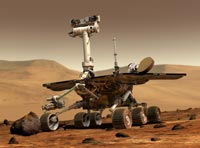| Where to Land on Mars? It's not as Easy as It Looks |
 |
 |
|
Artist's rendering of the Mars 2003 Rover |
Of all the places to land on Mars, where in the world should twin
rovers go? This question has been on the front burner of discussion
with Mars scientists who have the arduous task of selecting a site
where it is safe to land and yet is rich in rocks, layered terrain and other
geologic features that will beckon a host of scientific inquiries and
discoveries for the Mars Exploration Rover mission scheduled to
launch in 2003.
Mars scientists all agree on one thing: the search is on for landing
sites where water was once present on the surface of Mars. The science
instruments on the rovers are all geared toward understaning if the
planet was warmer and wetter in the past, and for how long.
Answering these questions is important to understanding how Earth and
Mars have differed in climate and geology throughout their development.
Since water is key to living organisms, they also address the potential
that life may have developed on Mars long ago.
Leading the Charge
As more than a hundred scientists gathered in study teams and
burned the midnight oil over six months of intense calculations, Dr. Matt
Golombek has overseen a lively but collegial process that has taken place.
As JPL's Mars Exploration Landing Site scientist, he looks after the
selection process, carefully weighing the choices at hand. Scientists and
engineers working with him have painstakingly narrowed the best places
to land from 185 to four, and are now focused on selecting the final two.
"We want to go to sites with terrains that will challenge our
minds but not the safety of the rovers," said Golombek, who was
also project scientist on the Mars Pathfinder mission and selected its
landing site.
Plainly speaking, he said, the science group has ruled out areas that
are flat and safe but boring, and have homed in on sites that appear flat,
safe and interesting. The site selection process is a convergence between
engineers who know the capabilities and limitations of the machines
they are sending to Mars, and scientists who can determine the
scientific worth of the areas accessible to the spacecraft. Everyone,
he said, is working toward that goal.
Full Text
Where to Land on Mars? It's not as Easy as It Looks
Narrowing the Options
Rocks: Too Much of a Good Thing?
The Four Finalists and their Runners-Up
Runners-Up
|